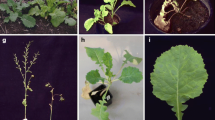Abstract
In a region of Australia with a Mediterranean-type climate Wheat streak mosaic virus (WSMV) infection of wheat occurs in localised epidemics following extended periods when no grass or cereal hosts are present. To achieve a greater understanding of the epidemiology of WSMV in this environment, diverse components of the disease cycle were examined, especially the importance of seed transmission in initiating epidemics. The role of seed transmission in providing WSMV inoculum sources for these epidemics was examined by determining WSMV seed transmission rates and susceptibilities in cereals, and in both annual and perennial grasses that occur locally. Also, examined were the patterns of spread of WSMV from simulated seed-borne infection sources external or internal to wheat plantings. When 11 wheat, 11 oat and seven barley cultivars, and six annual and five perennial grass species, were inoculated with WSMV, all cereal cultivars and annual grass species became infected. In contrast, none of the perennial grass species became infected despite inoculation by both infective sap and wheat curl mite (WCM, Aceria tosichella) vector. When seeds from all WSMV-infected plants from these inoculations to cereals and grasses were germinated, seed transmission was only found in wheat (0.03 to 0.1 %). These findings suggest seed transmission of WSMV is limited to wheat only. In three field studies involving wheat plantings where both simulated WSMV seed-borne infection in wheat and the WCM vector were present, WSMV infection was clustered in plants <4 m from infector plant infection sources. Regardless of whether WSMV infector plants were placed internally or externally, and killed by herbicide or left alive, there were no differences in WSMV spread to wheat plants. In addition, when internal WSMV infection sources were present, the rate and amount of WSMV spread in wheat were directly related to the number of infector plants introduced. Thus, when increasing levels of internal simulated seed-borne infection sources (0.1–1.4 %) were present final WSMV incidence increased (17–97 %). At a natural field infection site, after a long dry summer fallow, volunteer wheat seedlings emerged following autumn rains and were not removed before nine wheat cultivars were sown. All cultivars became infected (78–99 %) and seed transmission rates of 0.03–0.06 % were found in six cultivars. In a Mediterranean-type climate where there is an absence of WSMV infection sources during the hot, dry summer conditions between successive wheat crops, seed-infected wheat seedlings growing as volunteers or from sown infected wheat seed stocks play a critical role in initiating WSMV epidemics.






Similar content being viewed by others
References
Atkinson, T. G., & Grant, M. N. (1967). An evaluation of streak mosaic virus losses in winter wheat. Phytopathology, 57, 188–192.
Bockus, W. W., Bowden, R. L., Hunger, R. M., Morrill, W. L., Murray, T. D., & Smiley, R. W. (2010). Compendium of wheat disease and pests. Minnesota: The American Phytopathological Society.
Brey, C. W., Johnson, G. D., & Blodgett, S. L. (1988). Survey of Montana grasses for wheat curl mite (Acari: Eriophyidae), the vector of wheat streak mosaic virus. Journal of Agricultural Entomology, 15, 173–181.
Carew, M., Schiffer, M., Umina, P., Weeks, A., & Hoffmann, A. (2009). Molecular markers indicate that the wheat curl mite, Aceria tosichella Keifer, may represent a species complex in Australia. Bulletin of Entomological Research, 99, 479–486.
Christian, M. L., & Willis, W. G. (1993). Survival of wheat streak mosaic virus in grass hosts in Kansas from wheat harvest to fall wheat emergence. Plant Disease, 77, 239–242.
Clark, M. F., & Adams, A. N. (1977). Characteristics of the microplate method of enzyme-linked immunosorbent assay for the detection of plant viruses. Journal of General Virology, 34, 475–483.
Coutts, B. A., Thomas-Carroll, M. L., & Jones, R. A. C. (2004). Patterns of spread of Tomato spotted wilt virus in field crops of lettuce and pepper: spatial dynamics and safe planting distances. Annals of Applied Biology, 145, 231–245.
Coutts, B. A., Hammond, N. E., Kehoe, M. A., & Jones, R. A. C. (2008a). Finding Wheat streak mosaic virus in south-west Australia. Australian Journal of Agricultural Research, 59, 836–843.
Coutts, B. A., Strickland, G. R., Kehoe, M. A., Severtson, D. L., & Jones, R. A. C. (2008b). The epidemiology of Wheat streak mosaic virus in Australia: case histories, gradients, mite vectors, and alternative hosts. Australian Journal of Agricultural Research, 59, 844–853.
Coutts, B. A., Cox, B. A., Thomas, G., & Jones, R. A. C. (2014). First report of Wheat mosaic virus infecting wheat in Western Australia. Plant Disease, 98, 285.
Dwyer, G. I., Gibbs, M. J., Gibbs, A. J., & Jones, R. A. C. (2007). Wheat streak mosaic virus in Australia: relationship to isolates from the Pacific Northwest of the USA and its dispersal via seed transmission. Plant Disease, 91, 164–170.
Ellis, M. H., Rebetzke, G. J., & Chu, P. (2003). First report of Wheat streak mosaic virus in Australia. Plant Pathology, 52, 808.
Ellis, M. H., Rebetzke, G. J., Kelman, W. M., Moore, C. S., & Hyles, J. E. (2004). Detection of Wheat streak mosaic virus in four pasture grass species in Australia. Plant Pathology, 53, 239.
French, R., & Stenger, D. C. (2002). Wheat streak mosaic virus. Association of Applied Biologists, Descriptions of Plant Viruses No. 393. Online:http://www.dpvweb.net/dpv/showdpv.php?dpvno=393.
Gibbs, A. J., & Gower, J. C. (1960). The use of a multiple transfer method in plant virus transmission studies - some statistical points arising from the analysis of results. Annals of Applied Biology, 48, 75–83.
Hadi, B.A.R., Langham, M.A.C., Osborne, L., & Tilmon, K.J. (2011). Wheat streak mosaic virus on wheat: biology and management. Journal of Integrated Pest Management, 2, doi:10.1603/IPM10017.
Hawkes, J. R., & Jones, R. A. C. (2005). Incidence and distribution of Barley yellow dwarf virus and Cereal yellow dwarf virus in over-summering grasses in a Mediterranean-type environment. Australian Journal of Agricultural Research, 56, 257–270.
Hein, G. L., French, R., Siriwetwiwat, B., & Amrine, J. W. (2012). Genetic characterization of North American populations of wheat curl mite and dry bulb mite. Journal of Economic Entomology, 105, 1801–1808.
Hunger, R. M., Sherwood, J. L., Evans, C. K., & Montana, J. R. (1992). Effects of planting date and inoculation date in severity of Wheat streak mosaic virus in hard red winter wheat cultivars. Plant Disease, 76, 1056–1060.
Ito, D., Miller, Z., Menalled, F., Moffet, M., & Burrows, M. (2012). Relative susceptibility among alternative host species prevalent in the Great Plains to Wheat streak mosaic virus. Plant Disease, 96, 1185–1192.
Jiang, W., Garrett, K. A., Peterson, D. E., Harvey, T. L., Bowden, R. L., & Fang, L. (2005). The window of risk for emigration of Wheat streak mosaic virus varies with host eradication method. Plant Disease, 89, 853–858.
Jones, R. A. C. (2009). Plant virus emergence and evolution: origins, new encounter scenarios, factors driving emergence, effects of changing world conditions, and prospects for control. Virus Research, 141, 113–130.
Jones, R. A. C. (2013). Virus diseases of pasture grasses: incidences, losses, epidemiology and management. Crop Pasture Science, 64, 216–233.
Jones, R. A. C., & Barbetti, M. J. (2012). Influence of climate change on plant disease infections and epidemics caused by viruses and bacteria. CAB Reviews, 7(22), 1–32. (on-line publication) http://www.cabi.org/cabreviews.
Jones, R. A. C., Coutts, B. A., Mackie, A. E., & Dwyer, G. I. (2005). Seed transmission of Wheat streak mosaic virus shown unequivocally in wheat. Plant Disease, 89, 1048–1050.
Langham, M., & Glover, K. (2005). Effects of Wheat streak mosaic virus (genus: Tritimovirus; family: Potyviridae) on spring wheat. Phytopathology, 95, S56. Abstr.
Langham, M. A. C., Doxtader, D. C., Haley, S. D., Kalsbeck, S., Little, R. S., & Ibrahim, A. M. (2001). Yield and growth reductions in winter wheat infected with wheat streak mosaic virus. Phytopathology, 91, S52. Abstr.
Lanoiselet, V. M., Hind-Lanoiselet, T. L., & Murray, G. M. (2008). Studies on the seed transmission of Wheat streak mosaic virus. Australasian Plant Pathology, 37, 585–588.
Navia, D., de Mendonca, R. S., Skoracka, A., Szydlo, W., Knihinicki, D., Hein, G. L., da Silva Pereira, P. R. V., Truol, G., & Lau, D. (2013). Wheat curl mite, Aceria tosichella, and transmitted viruses: an expanding pest complex affecting cereal crops. Experimental and Applied Acarology, 59, 95–143.
Orlob, G. B. (1966). Feeding and transmission characteristics of Aceria tulipae Keifer as vector of wheat streak mosaic virus. Journal of Phytopathology, 55, 218–238.
Perry, J. N., Bell, E. D., Smith, R. H., & Woiwood, L. P. (1996). SADIE:software to measure and model spatial pattern. Aspects of Applied Biology, 46, 95–102.
Perry, J. N., Winder, L., Holland, J. M., & Alston, R. D. (1999). Red-blue plots for detecting clusters in count data. Ecology Letters, 2, 106–113.
Schiffer, M., Umina, P., Carew, M., Hoffmann, A., Rodoni, B., & Miller, A. (2009). The distribution of wheat curl mite (Aceria tosichella) lineages in Australia and their potential to transmit wheat streak mosaic virus. Annals of Applied Biology, 155, 371–379.
Seifers, D. L., Harvey, T. L., Kofoid, K. D., & Stegmeier, W. D. (1996). Natural infection of pearl millet and sorghum by wheat streak mosaic virus in Kansas. Plant Disease, 80, 79–185.
Sill, W. H., & Agusiobo, P. C. (1955). Host range studies of the wheat streak mosaic virus. Plant Disease Reporter, 39, 633–642.
Sill, W. H., & Connin, R. V. (1953). Summary of the known host range of the wheat streak mosaic virus. Transactions of the Kansas Academy of Science, 56, 411–417.
Skoracka, A., Rector, B., Kuczyński, L., Szydło, W., Hein, G., & French, R. (2014). Global spread of wheat curl mite by its most polyphagous and pestiferous lineages. Annals of Applied Biology. doi:10.1111/aab.12130.
Slykhuis, J. T. (1955). Aceria tulipae Keifer (Acarina, Eriophyidae) in relation to the spread of wheat streak mosaic virus. Phytopathology, 45, 116–128.
Somsen, H. W., & Sill, W. H. (1970). The wheat curl mite, Aceria tulipae Keifer, in relation to epidemiology and control of wheat streak mosaic. Kansas Agricultural Experiment Station Research Publication No. 162 (Kansas State University: Kansas, USA) 24 p.
Staples, R., & Allington, W. B. (1956). Streak mosaic of wheat in Nebraska and its control. University of Nebraska Agricultural Experiment Station Research Bulletin No. 178 (University of Nebraska: Nebraska, USA) 40 p.
Tatineni, S., Graybosch, R. A., Hein, G. L., Wegulo, S. N., & French, R. (2010). Wheat cultivar-specific disease synergism and alteration of virus accumulation during co-infection with Wheat streak mosaic virus and Triticum mosaic virus. Phytopathology, 100, 230–238.
Thomas, J. A., & Hein, G. L. (2003). Influence of volunteer wheat plant condition on movement of the wheat curl mite, Aceria tosichella, in winter wheat. Experimental and Applied Acarology, 31, 253–268.
Thomas, J. A., Hein, G. L., & Lyon, D. J. (2004). Spread of wheat curl mite and Wheat streak mosaic virus is influenced by volunteer wheat control methods. Plant Health Progress. doi:10.1094/PH-2004-1206-01-RS.
Velandia, M., Rejesus, R. M., Jones, D. C., Price, J. A., Workneh, F., & Rush, C. M. (2010). Economic impact of Wheat streak mosaic virus in the Texas High Plains. Crop Protection, 29, 699–703.
Workneh, F., Jones, D. C., & Rush, C. M. (2009). Quantifying wheat yield across the field as a function of wheat streak mosaic intensity: a state space approach. Phytopathology, 99, 432–440.
Acknowledgments
The authors wish to thank Eva Gajda, Peter Mangano, Stuart Vincent and staff at Medina Research Station for technical assistance. The Grains Research and Development Corporation provided financial support.
Author information
Authors and Affiliations
Corresponding author
Rights and permissions
About this article
Cite this article
Coutts, B.A., Banovic, M., Kehoe, M.A. et al. Epidemiology of Wheat streak mosaic virus in wheat in a Mediterranean-type environment. Eur J Plant Pathol 140, 797–813 (2014). https://doi.org/10.1007/s10658-014-0510-x
Accepted:
Published:
Issue Date:
DOI: https://doi.org/10.1007/s10658-014-0510-x




